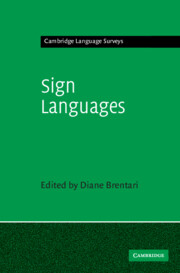Book contents
- Frontmatter
- Contents
- List of figures
- List of tables
- List of contributors
- List of sign language abbreviations
- Notational conventions
- 1 Introduction
- I HISTORY AND TRANSMISSION
- II SHARED CROSSLINGUISTIC CHARACTERISTICS
- 8 Notation systems
- 9 Verb agreement in sign language morphology
- 10 Functional markers in sign languages
- 11 Clause structure
- 12 Factors that form classifier signs
- 13 Handshape contrasts in sign language phonology
- 14 Syllable structure in sign language phonology
- 15 Grammaticalization in sign languages
- 16 The semantics–phonology interface
- 17 Nonmanuals: their grammatical and prosodic roles
- III VARIATION AND CHANGE
- Notes
- References
- Index
14 - Syllable structure in sign language phonology
from II - SHARED CROSSLINGUISTIC CHARACTERISTICS
Published online by Cambridge University Press: 05 June 2012
- Frontmatter
- Contents
- List of figures
- List of tables
- List of contributors
- List of sign language abbreviations
- Notational conventions
- 1 Introduction
- I HISTORY AND TRANSMISSION
- II SHARED CROSSLINGUISTIC CHARACTERISTICS
- 8 Notation systems
- 9 Verb agreement in sign language morphology
- 10 Functional markers in sign languages
- 11 Clause structure
- 12 Factors that form classifier signs
- 13 Handshape contrasts in sign language phonology
- 14 Syllable structure in sign language phonology
- 15 Grammaticalization in sign languages
- 16 The semantics–phonology interface
- 17 Nonmanuals: their grammatical and prosodic roles
- III VARIATION AND CHANGE
- Notes
- References
- Index
Summary
Introduction
In this chapter we will deal with the “signed syllable,” a unit of increasing interest in sign language phonology since the early 1980s. In general, we aim to give an overview of the syllable's nature and role in sign languages, focusing especially on the research done on American Sign Language (ASL) and Finnish Sign Language (FinSL). More specifically, our goals are: (i) to introduce the concept of the syllable, and argue for the existence of the syllable, in signed language; (ii) to present and compare, on a general level, the main models of the structure of the signed syllable and (iii) to contrast and compare the signed syllable with its spoken language counterpart. As regards a theoretical framework, most work on the signed syllable has been influenced by “generative phonology” (Kenstowicz 1994). Consequently, all the theories and models discussed in this chapter also belong to this school.
The syllable has already been investigated in a number of sign languages, most notably in ASL (e.g., Wilbur 1991, Perlmutter 1992, Sandler 1993, Brentari 1998), but also, for example, in Sign Language of the Netherlands (van der Kooij 2002) and Israeli Sign Language (Nespor & Sandler 1999). Recently, the syllable has also begun to be studied in FinSL (Jantunen 2005, 2006, 2007). From the point of view of exploring similarities and differences between sign languages, the data from FinSL, which we will present in this chapter, adds to our understanding of the crosslinguistic nature of the signed syllable.
- Type
- Chapter
- Information
- Sign Languages , pp. 312 - 331Publisher: Cambridge University PressPrint publication year: 2010
- 8
- Cited by

